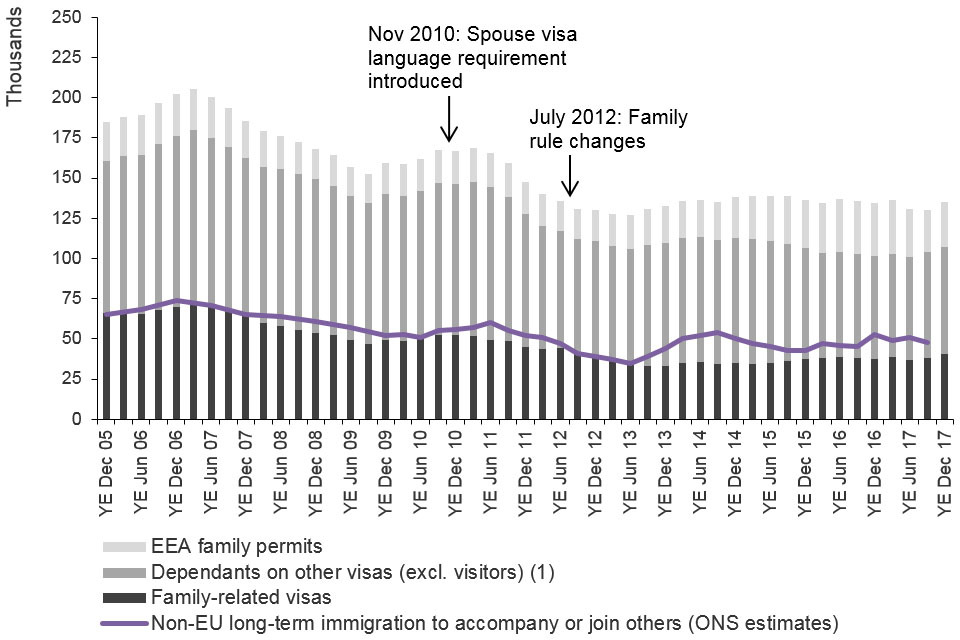Why do people come to the UK? (4) For family reasons
Updated 21 March 2018
Back to ‘Immigration Statistics’ October to December 2017’ content page.
This is not the latest release. View latest release.
Data relate to 2017 and all comparisons are with 2016, unless indicated otherwise.
This section contains data on:
- Family-related visas
- estimates of non-EU long-term immigration to accompany or join (i.e. those intending to stay for at least 12 months to accompany or join others)
For figures on Family-related grants of settlement as well as residence documentation issued to EEA nationals and their family members see ‘How many people continue their stay in the UK?’. Data on the family reunion category can be found in this edition’s ‘How many people do we grant asylum or protection to?’ section.
We provide a more detailed commentary on an annual basis. This is included in ‘Immigration Statistics, April to June 2017’.
1. Key facts
The combined total number of Family-related visas granted, including EEA Family permits granted to non-EEA nationals, and visas granted to dependants of other visa holders (excluding visitors) was 134,857, a similar level to the previous year (134,694).
Estimates published by ONS for the year ending 30 September 2017 suggest that 48,000 non-EU nationals immigrated long term to the UK to accompany or join others, with the intention of staying for a year or more. This was not a statistically significant change on the previous year (45,000). These estimates on those arriving to accompany or join others are not directly comparable with visa statistics.
2. Family immigration
Trends in Family-related visa granted, by visa type, 2016 to 2017
| 2016 | 2017 | Change | Percentage change | |
|---|---|---|---|---|
| Family-related visas granted | 37,792 | 40,708 | +2,916 | +8% |
| of which: | ||||
| Partners | 28,938 | 32,986 | +4,048 | +14% |
| Children1 | 2,614 | 2,257 | -357 | -14% |
| Other dependants | 6,240 | 5,465 | -775 | -12% |
| Dependants on other visas (excl. Visitor visas) | 63,810 | 66,721 | +2,911 | +5% |
| EEA Family permits granted | 33,092 | 27,428 | -5,664 | -17% |
| Total | 134,694 | 134,857 | +163 | 0% |
| Year ending September 2016 | Year ending September 2017 | Change2 | Percentage change | |
| Non-EU long-term immigration to accompany or join others (ONS estimates)3, 4 | 45,000 | 48,000 | +3,000 | +7% |
Sources:
Table vi 01 q (Entry clearance visas tables, volume 1).
ʻMigration Statistics Quarterly Report’, ONS.
Table notes:
- This category does not include children of a parent given limited leave to enter or remain in the UK for a probationary period. They are included in ‘Dependants on other visas (excl. Visitor visas)’.
- The increase had an estimated confidence interval of ±12,000.
- Data on non-EU long-term immigration to accompany or join others are estimates of the number of non-EU nationals intending to change their residence to the UK for at least 12 months.
- Estimates are based on the IPS. The latest available data are to the year ending 30 September 2017 and are provisional.
3. Long-term trends in family immigration
ONS estimates of non-EU immigration of those accompanying or joining others in the UK include those arriving on Family visas, as well as persons accompanying those who are arriving for other reasons, such as for work or study.
The chart below shows that ONS estimates of immigration to accompany or join others have, over the long term, followed a broadly similar trend to the total number of visas granted by the Home Office through the family route and to other dependants. ONS estimates are substantially lower as they exclude people who come to the UK but intend to stay for less than a year. Both measures of immigration for family reasons / to accompany or join others have generally fallen since the year ending March 2007, albeit with short-term increases in 2010 and again in 2013.
Family-related visas granted1 and long-term immigration to accompany or join others, 2005 to 20172

The chart shows the trends in visas granted and ONS estimates of immigration for family reasons / to accompany or join others between the year ending 31 December 2005 and the latest data published. The visa data are sourced from Visas table vi 04 q.
Sources:
Table vi 04 q (Entry clearance visas tables, volume 1), and corresponding datasets.
ʻMigration Statistics Quarterly Report’, ONS.
Chart notes:
- Includes all dependants (such as dependants for work and study), but excludes visitors.
- ONS estimates are based on data from the IPS. The latest available data are a quarter behind the latest available Home Office data, which come from administrative sources.
4. Data tables
Data on family immigration, sourced from Home Office administrative systems, can be found in the following tables:
Visas tables volume 1
Visas tables volume 2
Visas tables volume 3
Admissions tables
Extensions tables
Settlement tables
